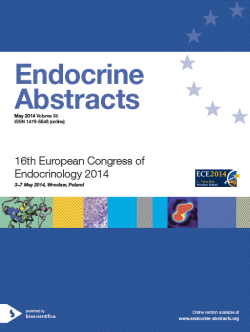Oral Communications
Diabetes and Obesity 2
ea0035oc11.1 | Diabetes and Obesity 2 | ECE2014
Inhibition of cardiac dysfunction in diabetic mice by treatment with brain natriuretic peptide
Jankowski Marek , Plante Eric , Gutkowska Jolanta
ea0035oc11.2 | Diabetes and Obesity 2 | ECE2014
An audit of the management of inpatient glycaemia using point of care testing data at Manchester Royal Infirmary
Mitchell Adam , James Emma , Jackson Nicola , Rutter Martin
ea0035oc11.3 | Diabetes and Obesity 2 | ECE2014
Improvement or stabilization of retinopathy and visual acuity after islet transplantation: a 5-year prospective study
Vantyghem Marie-Christine , Quintin Delphine , Labalette Pierre , Kerr-Conte Julie , Pattou Francois
ea0035oc11.4 | Diabetes and Obesity 2 | ECE2014
A novel adult human adipose stem cell model from inducible brown fat surrounding pheochromocytoma tumors
Di Franco Alessandra , Guasti Daniele , Mazzanti Benedetta , Ercolino Tonino , Nesi Gabriella , Bani Daniele , Forti Gianni , Mannelli Massimo , Valeri Andrea , Luconi Michaela
ea0035oc11.5 | Diabetes and Obesity 2 | ECE2014
Lipodystophic laminopathies are characterised by an increased intra/whole abdominal fat ratio with preserved fat/lean mass ratio and hypoleptinemia, in contrast with obese people, compared to controls
Le Mapihan Kristell , Leroy Clara , Ernst Olivier , Vigouroux Corinne , Lion Georges , Le Guillou Anne-Claire , Quintin Delphine , Douillard Claire , Vantyghem Marie-Christine




